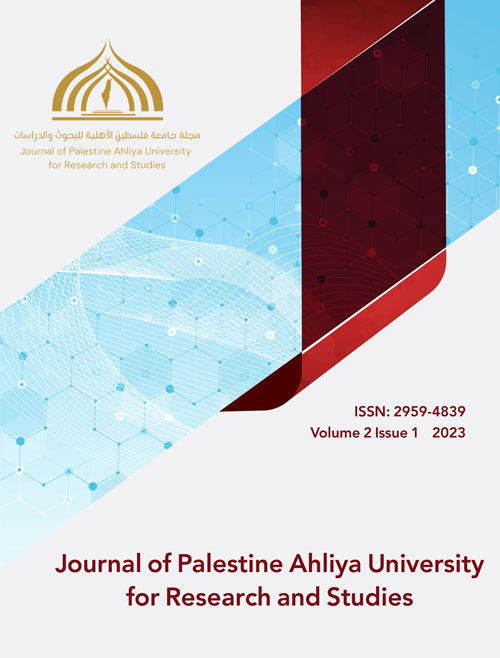Factors Influencing Female Student Participation in Student Council Elections at Palestinian Universities: An Application of the Theory of Planned Behavior
DOI:
https://doi.org/10.59994/pau.2023.1.28Keywords:
Student Council Elections, Female Students, Candidates for Elections, Palestinian Universities, Planned Behavior TheoryAbstract
This study aims to elucidate the variables influencing the decision of female students to run for student council elections in Palestinian universities. Adopting a quantitative approach, the investigation utilized 201 purposefully sampled questionnaires for data collection, which was subsequently analyzed using SPSS statistical software and structural equation modeling via Smart-PLS. The study revealed several critical factors that deter female students from participating in these elections. The primary deterrent was the perceived integrity of the elections, followed by the political convictions of the female students. Voter influence on the decision of female candidates and the perceived abilities of the female students as potential candidates also played moderate roles in the decision-making process. Interestingly, the impact of social and cultural structure on the decision to run could have been stronger, contrary to expectations. When viewed through the theory of planned behavior lens, the proposed study model accounted for 70% of the variation in the intentions of female students to run for student council elections. The results demonstrated that beliefs, attitudes, perceived behavioral control, and subjective norms had a significant statistical impact on their intention to run. Moreover, all intermediary relationships between beliefs and the intention to participate in the student council elections were statistically significant. Remarkably, the study found that approximately 31.17% of female students intended to run for the student council elections. This study’s uniqueness lies in its pioneering exploration of factors impacting female students' decision to run for student council elections in Palestinian universities, a topic seemingly overlooked in previous literature. It contributes significantly to scholarly discourse and provides valuable insights for researchers and policymakers.
Downloads
References
المراجع العربية
أبو الغيب، علا؛ والكرونز، إياد. (2015). واقع المشاركة السياسية للمرأة الفلسطينية في ظل قرار مجلس الأمن 1325، رام الله، طاقم شؤون المرأة.
أبو شعلة، وداد. (2007). واقع مشاركة المرأة في العمل السياسي ومدى تقبل المجتمع فكرة دخول المرأة معترك الحياة النيابية في البحرين. (رسالة ماجستير غير منشورة)، جامعة اليرموك، الأردن.
أبو فاشة، وسيم. (2009). النساء في المجالس والهيئات المحلية: واقع وتحديات. رام الله، جمعية المرأة العاملة.
اشتية، عمر. (2012). تجربة المرأة الفلسطينية في العمل البرلماني وأثر ذلك في تعزيز المشاركة السياسية 1996-2009م. (رسالة ماجستير غير منشورة)، جامعة النجاح الوطنية، فلسطين.
البلوشي، سليمان؛ الرواحي، ناصر. (2011). معتقدات معلمي التربية البدنية والعلوم في سلطنة عُمان حول التعلم التعاوني باستخدام نظرية السلوك المخطط. المجلة التربوية، 26(101)، 285-322.
جاد الله، حنين. (2007). التخطيط الرسمي لتنمية وتفعيل المشاركة السياسية للمرأة في فلسطين 1996-2006. (رسالة ماجستير غير منشورة)، جامعة النجاح الوطنية، فلسطين.
جاد، إصلاح. (2000). المرأة والسياسية. جامعة بيرزيت، معهد دراسات التنمية.
جقمان، جورج. (2015، 27 أبريل). هل توجد أية أهمية لانتخابات مجالس الطلبة في الجامعات الفلسطينية؟. جريدة الأيام.
الحسن، نسرين. (2008). الكوتا النسائية ودور المرأة في الانتخابات البلدية والبرلمانية: دراسة لحالة لواء بني كنانة – إربد. (رسالة ماجستير غير منشورة)، جامعة اليرموك، الأردن.
خضر، فتحي. (2008). دور الحركة الطلابية في جامعة النجاح الوطنية في ترسيخ مفهوم المشاركة السياسية 1994-2000. (رسالة ماجستير غير منشورة)، جامعة النجاح الوطنية، فلسطين.
رضوان، عبد العزيز. (2016). الأبعاد الاجتماعية والتنظيمية للمشاركة السياسية لطلاب الجامعات: دراسة ميدانية لعينة من طلاب جامعة الأزهر بفلسطين. (رسالة ماجستير غير منشورة)، جامعة عين شمس، مصر.
رمضان، صابر. (2016). دور الحركة الطلّابيّة في التحرّر الوطنيّ: الفرص والمعيقات. بيروت، مركز الزيتونة للدراسات والاستشارات.
الريماوي، صوفيا. (2007). الاتجاهات نحو الحاسوب ومعوقات استخدامه في التعليم لدى معلمي العلوم في المدارس الحكومية في الضفة الغربية. (رسالة ماجستير غير منشورة)، جامعة بيرزيت، فلسطين.
السدودي، انتماء؛ شديد، ثائرة؛ الهندي، محمد؛ وعيد، مي. (2018). نحو إعادة تفعيل الدور السياسي والنضالي للحركة الطلابية الفلسطينية. رام الله، المركز الفلسطيني لأبحاث السياسات والدراسات الاستراتيجية مسارات.
السين، منى؛ وعنبتاوي، منال. (2019). مشاركة طلبة الجامعة الأردنية في الانتخابات اللامركزية 2017. دراسات العلوم الإنسانية والاجتماعية. 46(32)، 417-438.
الشافعي، كمال؛ وعواد، نسرين. (2010). المرأة الفلسطينية في الأحزاب السياسية بين الحضور والغياب. رام الله، مركز إعلام حقوق الانسان والديمقراطية "شمس".
شتيوي، موسى. (2004). موقف الأردنيين من قضية مشاركة المرأة في الحياة السياسية. (رسالة ماجستير غير منشورة)، الجامعة الأردنية، الأردن.
عاشور، إياس. (2003). المشاركة السياسية للمرأة الأردنية. (رسالة ماجستير غير منشورة)، الجامعة الأردنية، الأردن.
العباسي، أميرة. (2001). المشاركة السياسية للمرأة المصرية ودور الإعلام في تفعيل هذه المشاركة (دراسة ميدانية). المجلة المصرية لبحوث الرأي العام، 2(1)، 87-112.
العيسى، بندر. (2008). المشاركة السياسية للمرأة السعودية من وجهة نظر المواطنين. (رسالة ماجستير غير منشورة)، جامعة اليرموك، الأردن.
الكفارنة، أحمد؛ وسالم، رفقة. (2011). دور الانتخابات النيابية (1989- 2007) في تمكين المرأة الأردنية سياسياً من وجهة نظرها. مجلة جامعة الأقصى (سلسلة العلوم الإنسانية)، 5(2)، 154-187.
المقداد، محمد. (2003). المرأة والمشاركة السياسية في الأردن (دراسة تحليلية وإحصائية) على ضوء نتائج الانتخابات النيابية لعام 2003. المنارة، 1(12)، 289-343.
نزال، ريما. (2006). المرأة والانتخابات المحلية: قصص نجاح، القدس. فلسطين، المبادرة الفلسطينية لتعميق الحوار العالمي والديمقراطية "مفتاح".
المراجع الأجنبية
Ajzen, I. (1985). From intentions to actions: A theory of planned behavior. In J. Kuhl & J. Beckmann (Eds.), Action control: From cognition to behavior (pp. 11–39). New York, NY: Springer Verlag.
Ajzen, I. (1991). The theory of planned behavior. Organizational Behavior and Human Decision Processes, 50(2), 179–211.
Ballington, J. (1999). The Participation of Women in South Africa’s First Democratic Election: Lessons From the Past and Recommendations for the Future. Electoral Institute of South Africa.
Bandura, A. (2007). Much ado over a faulty conception of perceived self-efficacy grounded in faulty experimentation. Journal of Social and Clinical Psychology, 26(6), 641–658.
Bian, X., & Moutinho, L. (2011). The role of brand image, product involvement, and knowledge in explaining consumer purchase behaviour of counterfeits: Direct and indirect effects. European Journal of Marketing, 45(1/2), 191–216.
Bryan, L. (2003). Heatedness of beliefs: Examining a prospective elementary teachers’ belief system about science teaching and learning. Journal of Reaserch in Science Teaching, 40(9), 835–868.
Cao, X., Yu, L., Liu, Z., Gong, M., & Adeel, L. (2018). Understanding mobile payment users’ continuance intention: a trust transfer perspective. Internet Research, 28(2), 456–476.
Cohen, J. (1988). Statistical Power Analysis for the Behavioral Sciences (2nd ed). New York, USA: Psychology Press.
Cohen, J. (1992). A power primer. Psychological Bulletin, 112, 155–159.
Cook, A. J., & Fairweather, J. R. (2007). Intentions of New Zealanders to purchase lamb or beef made using nanotechnology. British Food Journal, 109(9), 675–688.
Del Bosque, R. I., & Crespo, H. Á. (2011). How do internet surfers become online buyers? An integrative model of e commerce acceptance. Behaviour and Information Technology, 30(2), 161–180.
Dlodlo, N. (2014). The relationships among service quality, trust, user satisfaction and post-adoption intentions in M-payment services. Mediterranean Journal of Social Sciences, 5(23), 165–165.
Dorfleitner, G., Hornuf, L., Schmitt, M., & Weber, M. (2017). FinTech in Germany. Berlin, Springer Vieweg Verlag.
Fishbein, M., & Ajzen, I. (1975). Belief, attitude, intention, and behavior: An introduction to theory and research. Reading, USA: Addison-Wesley.
Francis, J., Eccles, M. P., Johnston, M., Walker, A. E., Grimshaw, J. M., Foy, R., Kaner, E. F. S., Smith, L., & Bonetti, D. (2004). Constructing questionnaires based on the theory of planned behaviour: A manual for health services researchers. Newcastle upon Tyne, UK: Centre for Health Services Research, University of Newcastle upon Tyne.
Giovanis, A., Tsoukatos, E., & Vrontis, D. (2020). Customers’ intentions to adopt proximity m-payment services: empirical evidence from Greece. Global Business and Economics Review, 22(1/2), 3–26.
Gold, A. H., Malhotra, A., & Segars, A. H. (2001). Knowledge management: An organizational capabilities perspective. Journal of Management Information Systems, 18(1), 185–214.
Hair, J. F., Hult, G. T. M., Ringle, C., & Sarstedt, M. (2016). A primer on partial least squares structural equation modeling (PLS-SEM). Thousand Oaks, California: Sage publications.
Hrubes, D., Ajzen, I., & Daigle, J. (2001). Predicting hunting intentions and behavior: An application of the theory of planned behavior. Leisure Sciences, 23(3), 165–178.
Im, H., & Ha, Y. (2011). The effect of perceptual fluency and enduring involvement on situational involvement in an online apparel shopping context. Journal of Fashion Marketing and Management, 15(3), 345–362.
Jones, M. P. (2009). Gender quotas, electoral laws, and the election of women: Evidence from the Latin American vanguard. Comparative Political Studies, 42(1), 56–81.
Khan, M. R., & Ara, F. (2006). Women, participation and empowerment in local government: Bangladesh union Parishad perspective. Asian Affairs, 29(1), 73–92.
Kim, H. B., Kim, T. T., & Shin, S. W. (2009). Modeling roles of subjective norms and eTrust in customers’ acceptance of airline B2C e-Commerce websites. Tourism Management, 30(2), 266–277.
Lane, J. C. (1995). The election of women under proportional representation: The case of Malta. Democratization, 2(2), 140–157.
Lerner, T. (2013). Mobile payment. Berlin, Springer Vieweg Verlag.
Lu, J., Wei, J., Yu, C. S., & Liu, C. (2017). How do post-usage factors and espoused cultural values impact mobile payment continuation? Behaviour & Information Technology, 36(2), 140–164.
McCarthy, M., de Boer, M., O’Reilly, S., & Cotter, L. (2003). Factors influencing intention to purchase beef in the Irish market. Meat Science, 65(3), 1071–1083.
Naspor, J. (1987). The role of beliefs in the Practice of teching. Jornal of Curriculum Studies, 19(4), 317–328.
Pedersen, P. E. (2005). Adoption of mobile internet services: an exploratory study of mobile commerce early adopters. Journal of Organizational Computing and Electronic Commerce, 15(3), 203–222.
Peredaryenko, M. (2016). Explaining Customer Purchase Intention Towards Perak Gold Dinar. )Unpublished doctoral thesis(, International Islamic University Malaysia, Malaysia.
Peredaryenko, M. (2019). Gold Dinar as a Consumer Product: Modified Version of the Theory of Planned Behaviour. International Journal of Economics, Management and Accounting, 27(2), 353–372.
Rule, W. (1987). Electoral systems, contextual factors and women’s opportunity for election to parliament in twenty-three democracies. Western Political Quarterly, 40(3), 477–498.
Scales, I., & Teakeni, J. (2006). Election of women in Solomon Islands. Journal of Pacific Studies, 29(1), 67–84.
Schierz, P. G., Schilke, O., & Wirtz, B. W. (2010). Understanding consumer acceptance of mobile payment services: an empirical analysis. Electronic Commerce Research and Applications, 9(3), 209–216.
Spary, C. (2014). Women candidates and party nomination trends in India–evidence from the 2009 general election. Commonwealth & Comparative Politics, 52(1), 109–138.
Straub, D. (1989). Validating instruments in MIS research. MIS Quarterly, 13(2), 147–169.
Tan, K. L., Memon, M. A., Sim, P. L., Leong, C. M., Soetrisno, F. K., & Hussain, K. (2019). Intention to Use Mobile Payment System by Ethnicity: A Partial Least Squares Multi-group Approach. Asian Journal of Business Research, 9(1), 36–59.
Tan, T. H. (2013). Use of Structural Equation Modelling to Predict the Intention to Purchase Green and Sustainable Homes in Malaysia. Asian Social Science, 9(10), 181–191.
Taylor, S., & Todd, P. A. (1995). Understanding information technology usage: A test of competing models. Information Systems Research, 6(2), 144–176.
Verma, S., Chaurasia, S. S., & Bhattacharyya, S. S. (2020). The effect of government regulations on continuance intention of in-store proximity mobile payment services. International Journal of Bank Marketing, 38(1), 34–62.
Wamuyu, P. K. (2014). The role of contextual factors in the uptake and continuance of mobile money usage in Kenya. The Electronic Journal of Information Systems in Developing Countries, 64(1), 1–19.
Welch, S. (1977). Women as political animals? A test of some explanations for male-female political participation differences. American Journal of Political Science, 21(4), 711–730.
Zhou, T. (2013). An empirical examination of continuance intention of mobile payment services. Decision Support Systems, 54(2), 1085–1091.

Downloads
Published
How to Cite
Issue
Section
License
Copyright (c) 2023 Journal of Palestine Ahliya University for Research and Studies

This work is licensed under a Creative Commons Attribution 4.0 International License.
مجلة جامعة فلسطين الاهلية للبحوث والدراسات تعتمد رخصة نَسب المُصنَّف 4.0 دولي (CC BY 4.0)











